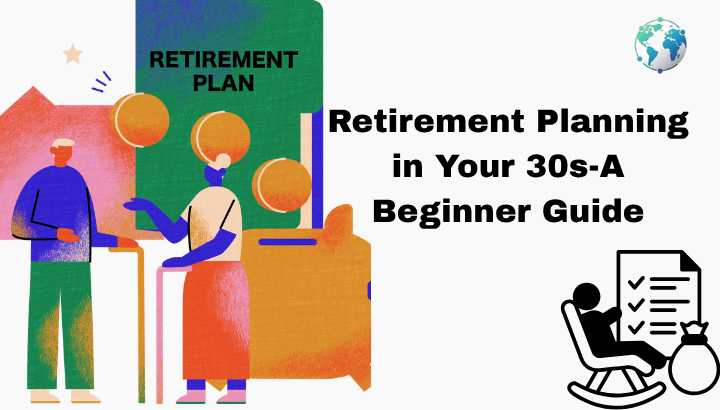Planning for retirement in your 30s might seem early but as we know that with career growth and family responses increasing, our cost of living is increasing day-by-day and inflation increasing every year. It is very important to plan as soon as possible for a better tomorrow.
In this beginner’s guide, we’ll walk through the retirement planning in your 30s and this guide will help you take smarter steps towards your financial goals.
Step-by-Step Guide to Retirement Planning in Your 30s
1. Set a Clear Retirement Goals
The first step to follow when you’re planning for retirement in your 30s is by setting a clear retirement goals, in which you need to:
- Decide when you’re planning to take retirement or at what age you want to stop working.
- Imagine what kind of lifestyle you want after retirement-simple, comfortable, or luxurious.
- Think about health care, travel, or home repairs that may cost even more in future.
By setting these clear retirement goals, you can estimate how much money you need to save for retirement.
2. Assess Your Current Financial Situation
It is to look and understand your current financial situation by calculating how much do you earn, how much do you have, how much do you spend, or how much do you owe, in which you need to:
- Know how much money you earn per month from your job, side businesses, and other sources.
- Write down all your expenses and overspending, so that you can have a clear idea about where to save and where to spend more.
- List credit cards, loans, and other liabilities.
- Make a list of your savings from different sources and where you’re investing your money like, mutual funds, ETFs, stocks, etc.,
This step will help you understand where you stand today and then you can plan better for your future goals according to your current financial situation.
3. Create a Retirement Budget
Estimate how much money you will need in the future after retirement for things like housing, good, healthcare, leisure. Remember that prices go up over time due to inflation, so it is really important to plan for higher costs in the future.
For example: $10,000 today may not have the same value after 20 years because prices will likely increase with the time.
That’s why it’s smart to assume an average inflation rate of 5-7% per year in most countries.
4. Start an Emergency Fund
Before you think about investing your hard earned money somewhere in the market, make sure you have enough savings to cover 3 to 6 months of your regular expenses and keep this money in a savings account where it can stay safe and easily used.
This saved money really helps when you face emergencies like losing your job or dealing with serious medical problems, as it gives you support and peace of mind during tough times.
Investment Options to Consider
When you’re in your 30s and working, it is really important to explore long-term investment plans to earn good returns and secure a safe financial future. Here are a few popular choices:
1. Employee Retirement Plans
Try to save as much money as you can in your working sector’s retirement plan. Many working sectors add some extra money when you save, it’s like getting free money to help you save more for the future.
Plans like 401(k) in the USA and EPFs in India can easily help you build a retirement fund.
2. Mutual Funds and SIPs
If you invest a fixed amount of money every month through SIPs (Systematic Investment Plans) in equity mutual funds, then it can help you grow money with good returns over time.
Usually, these investments depend on the stock market and returns can go up or down, but you don’t have to worry about that, because a professional fund manager takes care of that.
3. Public Provident Funds (PPFs)
It is a safe way to save money for retirement in your 30s, because it is backed by the government and it also gives you tax benefits.
The returns are though moderate, but it is a good option for people who don’t want to take any risk with their money.
4. National Pension Scheme (NPS)
It is a great long-term plan to save money for your retirement, because it gives you tax benefits.
It also lets you choose where your money is invested, like in shares, government funds, etc., and when you retire, you get a regular monthly income from the money that you saved.
5. Stocks and ETFs
Stocks and Exchange Traded Funds (ETFs) are a great way to save money for your retirement if you’re okay with taking some risks.
The returns totally depend upon the market ups and down, so you should have the risk tolerance before investing your money.
Smart Strategies for Long-Term Success
1. Automate Savings
Set up an automatic service from your bank account to your retirement account every month. It helps you stay consistent without making any extra efforts.
It also removes your temptation to buy unnecessary things from your savings accounts.
2. Increase Contributions with Income
Whenever you get a raise in your salary or bonus, try to transfer that money into your retirement account immediately, instead of spending it on things you don’t really need.
It’s a good habit for your lifestyle and helps you build a better future.
3. Avoid Early Withdrawal
Most retirement savings accounts charge you with a penalty if you take out money early for small usage.
So, try not to use your retirement savings money unless you need it for an emergency.
Common Mistakes to Avoid
- Don’t wait for too long to start saving for your retirement, Start as early as you can.
- Always keep in mind about the rising rate of inflation.
- Don’t just depend solely on your employer pension, build your own independent savings as well.
- Avoid random investment, study the market deeply before investing your money.
- Invest your money in different plans like health insurance, life insurance, and home insurance.
Conclusion
Planning for retirement in your 30s is simple and not at all scary. You just need to set a clear goal, save money regularly, invest it smartly, and check your progress from time to time.
Starting now in your 30s will definitely help you build a safe and stress-free future for yourself and your loved ones and your 60-year-old will thank you.
Know someone who needs retirement saving tips? Share it with them! And drop your thoughts in the comment section. We’d love to hear from you and keep the conversation going!
FAQs Related to Retirement Plannings
Why should I start retirement planning in my 30s?
The earlier you start saving, the more money can grow over time. This means you will need to save less later and still have a good amount when you retire.
How much should I save for retirement in my 30s?
Try to save around 15% of what you earn every year. Even if you can’t save that much now, starting with a smaller amount is better if you start saving early. It is better than not saving anything at all.
What are the best retirement saving options for people in their 30s?
You can save through plans like a 401(k), PPF, NPS, mutual funds, or SIPs. These will help you grow money easily with time. Plans like PPF and NPS are government backed plans with tax relaxations.
Is it too late to start retirement planning at 35?
Not at all. It’s a great time to start. You just need to be regular and smart with your savings and try not to spend too much on unnecessary things.
How can I balance retirement saving with other financial goals like buying a home or raising a family?
Make a monthly budget, save a bit for each goal, and build an emergency fund, because it can cost you a lot if you ignore the emergency fund. Small steps now can help you manage everything more easily later.


2 thoughts on “Retirement Planning in Your 30s-A Beginner Guide”